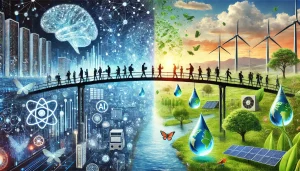
Artificial intelligence (AI) is revolutionising industries, powering breakthroughs in healthcare, transforming supply chains, and enhancing the global energy transition. But as two megatrends, AI and sustainability, collide, we face an urgent question: can we harness this transformative technology without compromising the planet?
AI’s insatiable appetite for energy has sparked debates about its environmental cost. But what’s less discussed, yet just as critical, are the cooling requirements that keep AI systems functional and efficient. These hidden energy drains often double the ecological footprint of AI, and addressing them is as important as optimising algorithms or using renewable energy.
Let’s peel back the layers and uncover how we can innovate responsibly.
The Hidden Energy Cost of AI: Cooling Requirements
AI thrives on data, and a lot of it. From training massive models like GPT-3 to running real-time analytics, data centres buzz with millions of servers working tirelessly. But this power comes at a price.
The heat generated by AI operations is staggering, demanding extensive cooling to prevent system failures. Here’s a stark reality check:
- Energy Demand: By 2027, data centres are projected to consume six times more water annually than the entire nation of Denmark. Imagine billions of litres of water used, not for human sustenance, but to prevent AI systems from overheating.
- Carbon Footprint: Training advanced AI models can emit as much carbon as the lifetime emissions of five cars, and the cooling systems required can double or even triple this impact.
Is the environmental toll inevitable? Absolutely not. With creativity and accountability, we can turn AI into a force for good, not just in what it delivers, but how it operates.
Rethinking Cooling: Innovating for Sustainability
The answer lies in innovation. Here’s how we can rewrite the narrative:
- Repurpose Heat Waste
Data centres don’t just consume energy, they can give it back. Cities like Paris have pioneered using waste heat from data centres to warm buildings and even Olympic swimming pools. It’s a smart, circular solution that transforms a problem into a benefit. - Leverage Renewable Energy
It’s not enough to power AI with electricity, we need clean electricity. Leading-edge companies are shifting to 100% renewable energy for their data centres, combining solar, wind, and hydroelectric power to slash carbon emissions. But this is just the beginning; the challenge is ensuring consistent availability to meet demand. - Embrace Advanced Cooling Technologies
Liquid cooling and AI-optimised climate control systems are transformative innovations. By immersing servers in specialised cooling liquids or using predictive algorithms to regulate temperatures, we can reduce both energy use and resource waste. - Redefine Efficiency Metrics
Instead of measuring success by computing power alone, organisations must adopt new metrics that account for sustainability. The true benchmark for AI in the future won’t just be intelligence, it’ll be responsible intelligence.
Leadership in a Transformative Era
We’re standing at a crossroads. AI can either exacerbate the climate crisis or become a critical player in solving it. The choice lies in the hands of innovators, decision-makers, and consumers like you.
- If you’re a leader in tech, ask yourself: How can my organisation drive efficiency without sacrificing sustainability?
- If you’re an AI enthusiast, consider: How can I advocate for more transparency around the environmental impact of AI?
- If you’re a global citizen, challenge industries: What are you doing to make AI greener?
AI doesn’t have to be the villain in the sustainability narrative. It can be the hero, but only if we demand solutions that go beyond the status quo. Together, we can make AI a symbol of progress and responsibility.
